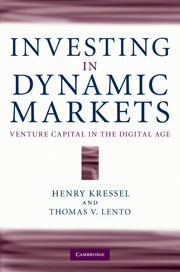Book contents
- Frontmatter
- Contents
- List of figures
- List of tables
- Acknowledgments
- Introduction
- 1 Hot markets, investment waves, bubbles, charlatans
- 2 Financing high-risk businesses
- 3 Venture investing: An uncertain science
- 4 Investing in a transformed market: Telecommunications
- 5 Investing in a transformed market: Semiconductors
- 6 Investing in early-stage technology: The Internet in the 1990s
- 7 Software products and services
- 8 Venture capital: Past and future
- Appendix
- Bibliography
- Index
4 - Investing in a transformed market: Telecommunications
Published online by Cambridge University Press: 06 July 2010
- Frontmatter
- Contents
- List of figures
- List of tables
- Acknowledgments
- Introduction
- 1 Hot markets, investment waves, bubbles, charlatans
- 2 Financing high-risk businesses
- 3 Venture investing: An uncertain science
- 4 Investing in a transformed market: Telecommunications
- 5 Investing in a transformed market: Semiconductors
- 6 Investing in early-stage technology: The Internet in the 1990s
- 7 Software products and services
- 8 Venture capital: Past and future
- Appendix
- Bibliography
- Index
Summary
Light is an old friend … The visionaries who foresaw a wired city were wrong – we will have a fibered society instead. We can all watch it happen.
Communications of one kind or another have always played an important role in human affairs. Battles have been won or lost, tragedies averted or assured, empires strengthened or imperiled by the timely delivery of crucial messages. Yet for most of recorded history the technology of communications remained static.
The first big leap forward in communications technology did not happen until the nineteenth century. That is when the invention of the telegraph and the telephone ushered in the age of electronic communications.
It took another one hundred years for the next dramatic advances to arrive. And they were giant steps indeed. Satellite communications was one major new invention. But the most important advance of all, digital technology, first appeared commercially in the 1970s. It quickly displaced analog systems, revolutionizing the way people around the world communicated with each other. Digital communications also transformed the world economy.
The invention and deployment of fiber optic systems, electronic switching, and other technologies associated with digital communications was fueled by multi-trillion dollar investments. Some of them came from venture capital funds, including Warburg Pincus.
In this chapter we will discuss five investments Warburg Pincus made in the telecommunications field before 2000. These were selected to illustrate how investments emerged in an explosive growth industry where multiple avenues to build valuable companies appeared to exist.
- Type
- Chapter
- Information
- Investing in Dynamic MarketsVenture Capital in the Digital Age, pp. 96 - 126Publisher: Cambridge University PressPrint publication year: 2010



